Proto-DUNE at CERN: New technologies for new discoveries
Following many years of R&D work, recent results from ProtoDUNE-SP, the single-phase DUNE Far Detector prototype at the CERN Neutrino Platform, now validate the Liquid Argon Time Projection Chamber (LArTPC) technology choice for DUNE providing the necessary information for the DUNE Technical Design Report (TDR) [https://arxiv.org/abs/2002.03010] recently published by the collaboration.
The ProtoDUNE experimental program is designed to test and validate the technologies and design that will be applied to the construction of the DUNE Far Detector at the Sanford Underground Research Facility. (Image: CERN).
ProtoDUNE-SP (NP04) represents a crucial part of the effort towards the construction of the first DUNE far detector module (17 kt total LAr mass) but with its ~1 kt of mass is also a significant experiment in its own right. It may well be the biggest prototype ever built. Impressively following the official approval of proto-DUNE in December 2015, from the fabrication of the detector components in the US and around the world, tests and assembly inside the cryostat built at CERN and up to the commissioning and start of operation, all took less than three years.

Previous expertise and a well-coordinated global effort allowed to build and operate the new detector prototype in record time as shown in the above photos. Credit: DUNE collaboration.
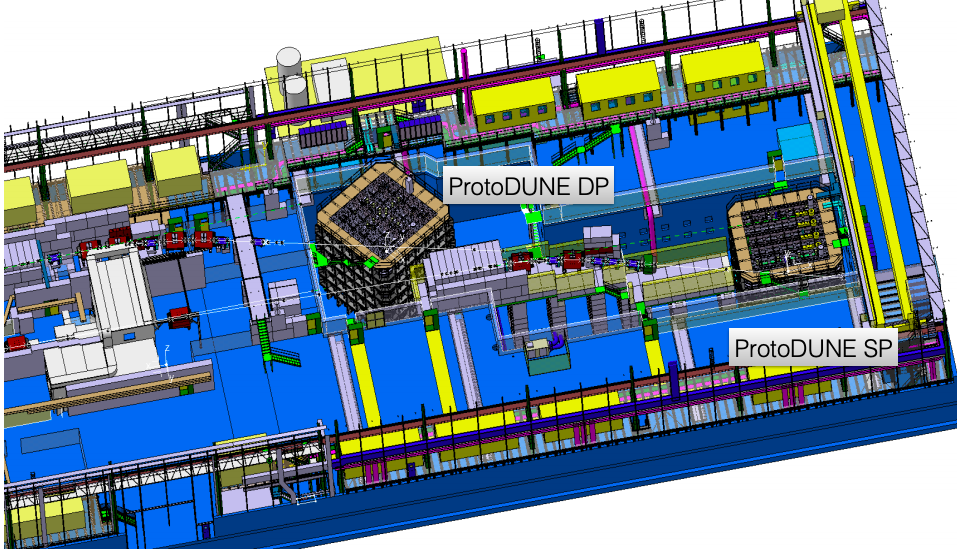
Location of the ProtoDUNE-SP and ProtoDUNE-DP in the EHN1 experimental area at CERN’s Prévessin site. Credit: DUNE collaboration.
Building and operating a new detector of this volume and complexity in such a short lapse of time was an amazing achievement. It was the result of a global collaborative effort of many DUNE groups mixed with CERN’s know-how and existing infrastructure. “If one makes a prototype that is twice bigger than the biggest LArTPC experiment for physics built so far, this tells you how incredible the size of DUNE will eventually be and also how fundamental is considered this step” says Fermilab’s Flavio Cavanna, co-coordinator of the ProtoDUNE effort at CERN and continues “The liquid Argon TPC was always considered as a promising break-through in particle detection technology, but it is only now thanks to the endorsement of the HEP community at large – from Fermilab to CERN, from the US to Europe and the International - that successfully build ProtoDUNE and demonstrated through its great performance that the way to DUNE is open”.
Major underground neutrino experiments currently employ the Water Cherenkov technology. For example, Super-Kamiokande in Japan uses a great number of phototubes surrounding a very large volume of water and looks for Cherenkov light rings emitted when an incoming neutrino creates an electron or a muon in the water. This is a relatively simple technology that in the course of decades of continued use and refinements has proven to be extremely robust and reliable. According to Cavanna, “The greatest discoveries in neutrino oscillations came from Cherenkov detectors. Looking now for new discoveries, a new technology - capable of providing data of unprecedented quality, with fine detailed images of the neutrino interaction, individual identification of the emitted particles and a precise measurement of their energy - is deemed as a key element of the endeavour”.
LArTPCs promise exquisite neutrino detection capability and efficient background rejection. The long and in the end very successful development of the technology was pursued by the ICARUS Collaboration, starting back in the early ‘90s and up to the realisation of the first large-scale LAr detector, featuring 2 x 370 t LAr modules, built at the INFN Gran Sasso National Laboratory in Italy and operated from 2010 to 2013 on the CNGS high energy long baseline neutrino beam. In the meantime, at Fermilab ArgoNeuT a very small LArTPC first operated in 2009 on the NuMI beam – a lower, few GeV energy neutrino beam – producing a lot of physics results and insight on neutrino interaction mechanisms. More recently, in 2015 a mid-large size, about 100 t liquid-argon detector called MicroBooNE started operating (and still is) on the Booster neutrino beam, the other Fermilab beam at even lower energy. MicroBooNE is exploring about some controversial observations from previous short baseline experiments, that if interpreted as due to neutrino oscillation may point to a possible new type of non-interacting neutrinos, therefore called “sterile”. Nowadays, on the same beam line, Fermilab is preparing to start operating the refurbished ICARUS detector, now in its new home in Illinois, and another large LArTPC – SBND - is advanced in construction. These two will be acting as far and near detector respectively to fully resolve the quest for sterile neutrinos.
A big leap in detector size is now ahead of us with DUNE, also considering the correlated incremental complexity for operating deep underground. Unlocking the mystery of the matter's abundance unbalance in the Universe by detecting the difference in oscillation patterns between GeV neutrinos and antineutrinos generated at far distance is one of the the primary goals of the DUNE long-baseline experiment. However, the LArTPC for this experiment must stretch its sensitivity for searches of those rare signals at much lower energies, that could possibly come from SuperNova neutrinos, from solar neutrinos and possibly from other sources of phenomena beyond the Standard Model, thus offering a diverse physics programme. According to Cavanna, “LArTPC is a finer and articulated technology that inaugurates a new era in neutrino physics and may expand our understanding of fundamental, though yet uncovered, phenomena in our Universe. In this scenario, ProtoDUNE serves as a bridge toward DUNE, allowing not only to understand how it can be scaled up to the much larger size needed for DUNE, but also to test and further perfect the technology toward its ultimate limits. We really want to see how far we can go, and test beam data is a perfect playground for this”.
A great feature of the LArTPC technology is that when you build a new detector – and is done right, filled with pure liquid Argon, you can immediately have a fully responsive detector. “You push the HV button of the power supply and as soon as the electric field inside the TPC reaches its nominal value, a second later you get the first event on your screen, crisp and clean, no need of complicated software manipulation of data, no signal filtering or noise suppression algorithms. You can just stay there staring at the beautiful events appearing on your laptop’s screen – Cavanna says - or even better on the large screens in the control room”. This is what happened on September 21, 2018 around 9:30 in the morning at the CERN Neutrino Platform. The ProtoDUNE detector, after an incredible one-year long rush to assemble the detector in time to meet the beam, smooth and flawless reached its nominal HV and immediately started collecting data from the CERN’s beam in the North Area and continued until the beams went off for LS2. ProtoDUNE-SP collected more than 4 million triggers of particle interactions in the LArTPC. To better visualize the spectacular high-energy electromagnetic and hadronic showers developing in the hundreds of cubic meters fully active LAr volume of ProtoDUNE a live, 3-D event display of the liquid-argon detector was made available showing the revolving and zoomable image of the events just captured in all details as never seen before [a gallery of ProtoDune-SP events is available HERE].

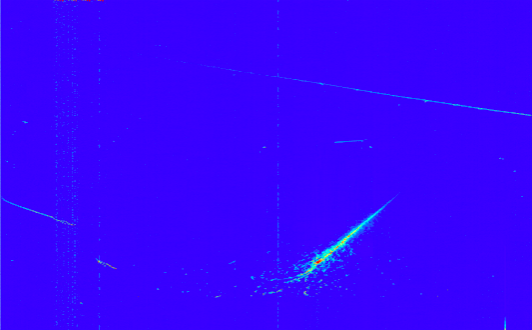
These are the very first events seen after reaching nominal electric field. The LAr filling was just completed a few days before and purity level – increasing day by day through continuous filtration – was just enough to “see” the first 30-40 cm of the TPC volume in front of the wire planes. The event above is part of a hadronic shower from a beam pion interacting before entering the TPC. The event below is an EM shower induced by cosmics. Credit: DUNE collaboration.

A reconstructed test-beam π+ (entering the ProtoDUNE-SP TPC from the red circle) interacting inside ProtoDUNE-SP with a number of coincident cosmic ray muons. Credit: DUNE collaboration.
“ProtoDUNE-SP collected more than 4 million beam triggers of particle interactions in the TPC in a few weeks of beam time. The collected data - with huge data volume per event - were transmitted, the events reconstructed and shared immediately with collaborators around the globe demonstrating how future DUNE datasets will be collected and distributed for analysis with the collaboration”, Cavanna says. The work of the ProtoDUNE analysis team was first to fully characterize the performance of the detector and calibrate it, and then as the next step to perform physics measurements of hadron interactions on argon nuclei relevant for the future neutrino oscillation studies in DUNE. For example, the inclusive and exclusive interaction cross sections of charged pion on Ar nuclei have never been measured before. In the GeV neutrino interactions expected in DUNE, pions are produced and these may re-interact inside the target Ar nucleus with these same mechanisms observed with test-beam pions. The collaboration has just announced that a first paper is ready for publication, quite remarkably only one year after the beam run was completed and while data taking with cosmics is still going on. It contains details of the detector characterization with beam particles and a thorough analysis of the detector performance. Under several aspects the results are found better than expected from MC simulations or from previous bench tests of detector components.
The photo-detector, for example, by detecting the abundant scintillation light from ionizing events in LAr, is meant to provide prompt information about the interaction time (t0 time) necessary for the reconstruction of the event in the TPC. The excellent response of the ARAPUCA photo-detectors in ProtoDUNE-SP demonstrated during the beam test, led the team thinking that it can be more than an auxiliary detector for the TPC. As Cavanna notes: “The performance of this element, somehow exceeding our expectations, made us think that the photo-detector can act as an additional detector on its own, just like to have two detectors in one, offering valuable information for the physics of the events that we observe”. Combined with the TPC, while paving the way for a more precise calorimetric energy reconstruction, it should allow to more accurately identify the nature of the recorded events, in particular in the low energy range of the astrophysical neutrinos. How these developments could enhance the physics reach of DUNE is currently under study.
From the cold electronics readout of the TPC, a remarkable signal-to-noise (S/N) ratio of 40 was measured from raw data, largely exceeding the predicted figure. And when noise suppression through offline software was applied to data, S/N further improved to ~50, pushing down the energy threshold for signal detection. In addition to the excellent behaviour of the detector, the extraordinary purity level of the liquid Argon, achieved by close-loop recirculation through a system of Oxygen adsorbers and molecular sieves, and the very careful grounding and shielding adopted to protect the readout electronics against ambient EM noise and interferences made the data recorded by the ProtoDUNE-SP LArTPC of unprecedented quality.
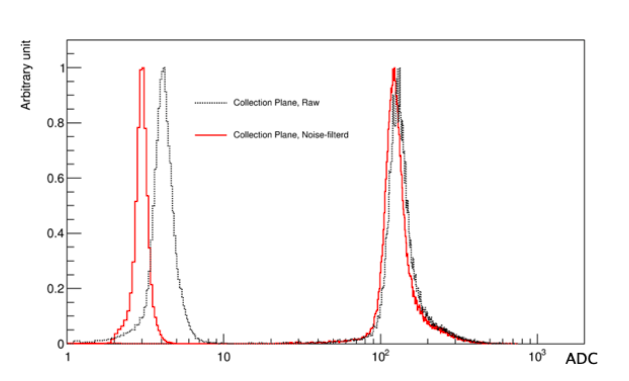
ProtoDUNE-SP exhibits an excellent Signal-to-Noise ratio: the signal is the minimum detectable signal (black peak on the right), that corresponds to the charge of a mip track detected by an individual channel of the TPC (wire+Cold Electronics read-out). The noise is measured by the fluctuation of the electronics response in absence of signal (black peak on the left). Software algorithms can be applied to suppress residual (coherent) electronic noise without modifying the signal (red histograms), and thus further enhancing the Signal-to-Noise ratio.
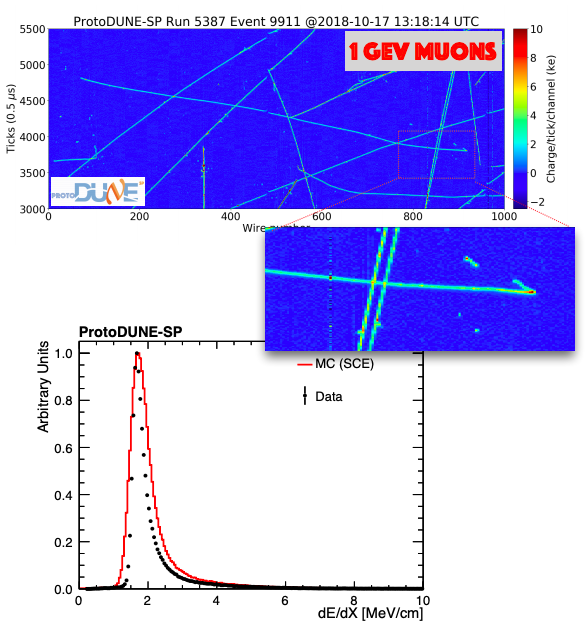
Proto-DUNE-SP demonstrates excellent capabilities for calorimetry. Thanks to the TPC, the readout electronics and the analysis software the analysis resolution is better with the detector than in the MonteCarlo simulations. Several examples including protons, pions and muons were presented by F. Cavana during a recent CERN Colloquium. Credit: DUNE collaboration.
One of the major challenges in the data analysis was the large number of cosmic rays – 70 on average – overlaid to the beam event in the same recorded time frame. “Operating on surface in the North Area hall at CERN, we had to deal with a cosmic rate million times higher than what the DUNE detector will see once installed in the kilometer-deep cavern at the Sanford Underground Research Facility in South Dakota” explains Cavanna, “the beam event must be extracted from the crowd of cosmic tracks nearby, and the electric field distortion created inside the TPC must be corrected… not at all an easy job!”. To deal with this challenge, starting from the experience of MicroBooNE, also running on surface, the collaboration developed an offline analysis framework that allowed decouple from the cosmic background and the correlated space charge effects. “Developing this complicated analysis framework enabled us to run an underground neutrino experiment on a hadron (and electron) beam line on the Earth’s surface!” concludes Cavanna.
Those who recently visited the North Area may have seen that indeed there are two almost identical ProtoDUNEs operating nearby one another. So far, we discussed ProtoDUNE-SP, the first that came online. The other one – dubbed ProtoDUNE-DP - activated one year later in August 2019, implements a novel version of the LArTPC technology, coined “Dual Phase” as both liquid and gas forms of argon are employed to record the tracks. The gaseous phase is used to amplify faint ionization signals generated in the liquid phase. The sensors are located at the top of the detector inside the gaseous argon. Compared to the single-phase technology, this setup could yield stronger signals and thus search for rare processes at lower energy that could be discerned from large backgrounds. When fully tested and validated, this new technology is expected to be adopted in one of the successive modules of the DUNE experiment.

Schematic of the Proto-DUNE double-phase LAr TPC concept currently tested at CERN (not to scale). Credit: DUNE collaboration.
Dual-phase technology presents a second advantage; as all the electronics boards are located on top of the gas layer they can be accessed via special chimneys without disrupting the liquid phase of the detector where LAr is kept at a temperature of -184 oC. Since last summer, the dual-phase prototype (ProtoDUNE-DP, NP02) is recording cosmic data and the collaboration is analyzing them. Testing a new technology often brings new challenges! During the tests, the team observed the formation of bubbles and waves on the liquid argon surface. This is critical because the signal in the gas comes from the extraction of the ionization charge through the liquid Argon surface, and any perturbation can compromise the extraction. The origin of the formation of these bubbles and waves is not clear, but the team discovered that the phenomenon is mitigated by increasing the pressure of the gas above the liquid. Solving this issue and studying the performance of the dual phase detector will open the way for large-scale application of the dual phase technology in DUNE.
The successful operation of the ProtoDUNE-SP detector at the CERN Neutrino Platform was a crucial step towards proving the capability of doing physics with the new LArTPC technology in the DUNE experiment. The ProtoDUNE-SP first paper reporting on the detector performance will soon be publicly available. The outcomes of the ongoing tests of ProtoDUNE-DP with the dual phase detector technology will help decide the number of modules using the single-phase and dual phase technologies in the final DUNE experiment.
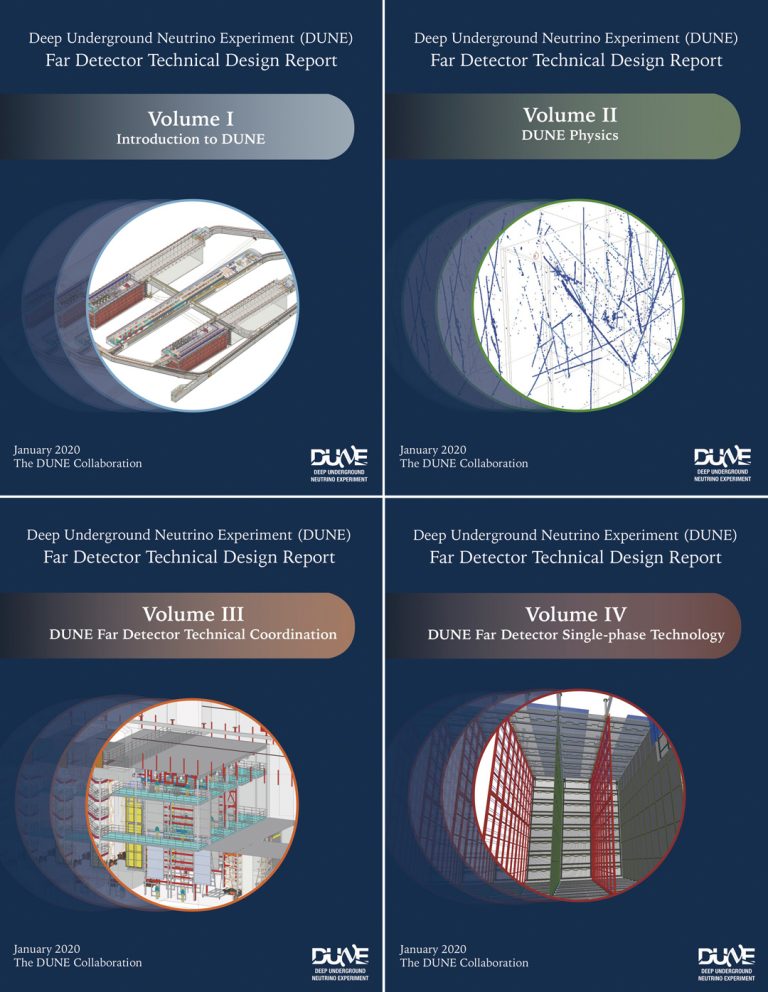
The four volumes of the DUNE Far Detector Technical Design Report published in February are available here:
Vol.I: https://arxiv.org/abs/2002.02967
Vol.II: https://arxiv.org/abs/2002.03005,
Vol.III: https://arxiv.org/abs/2002.03008,
Vol.IV: https://arxiv.org/abs/2002.03010

